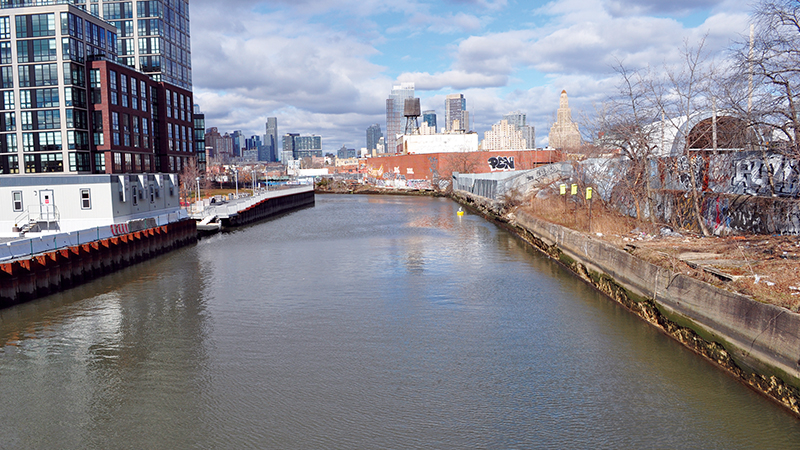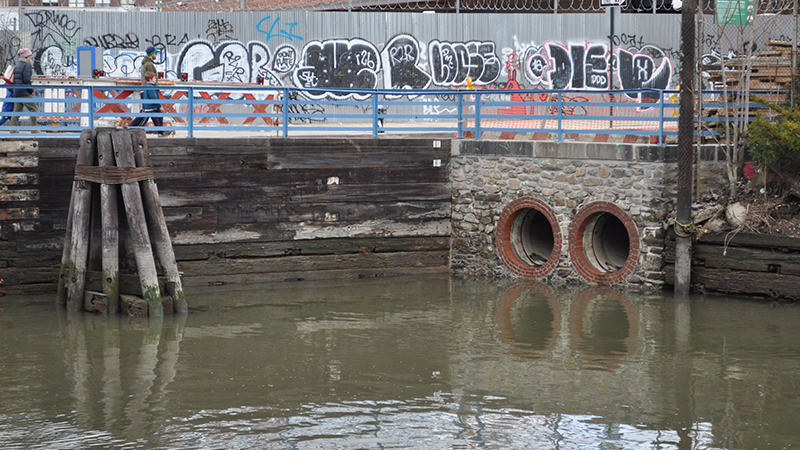Running the 1.8 miles from Butler Street to Upper New York Bay, the Gowanus Canal in Brooklyn, New York City, is considered one of the United State’s most polluted waterways. The canal was dug from a natural creek in the mid-1800s and for over a century was the dumping grounds of the heavy industry that lined its banks. Sewage tanks along the waterway still frequently overflow into the stagnant canal, contributing even more to the mess. There’s no sugar coating it—the water is toxic, smells terrible, and floods into surrounding neighborhoods with each heavy rain. Samples of Gowanus water have tested positive for E. coli, coal tar, PCBs, mercury and lead. Scientists have also found high levels of typhoid, cholera, dysentery, and tuberculosis in the water. In March of 2010, the Environmental Protection Agency (EPA) classified the Gowanus Canal as a Superfund site because of its hazardous waste contamination and the threat it poses to human and environmental health.
In spite of all of this, Virginia Fall, a second-year graduate landscape architecture student, was excited to visit the Gowanus area to see the site firsthand. In fact, she rearranged her course schedule to take the urban design studio (ARC 503/LAR 500 Graduate Studio) early because she “caught wind that the class was going to New York.” The studio, taught by Professor of Architecture Robin Abrams, PhD, FAIA, ASLA, and Assistant Professor of the Practice George Hallowell, PhD, AIA, was fortunate to receive a grant from the City Design Foundation, allowing students to travel to the Gowanus Canal, see the site firsthand, and conduct an initial research analysis and inventory.
In 2013, the EPA finalized a plan to clean up the 10 feet of contaminated sediment on the canal floor. With discussion of cleanup, hope for the canal and the surrounding area has sprung and residents, stakeholders, and designers are beginning to reimagine the Gowanus area. After returning from the site, the design students collaborated to create their own plan for the area. “Our hope was to throw our hat in the ring—is that the expression?” Fall says, laughing a bit, “—to say what this space could be and how it could be functional and useful on a social and economic front.”
The GoZed would be a self-sustaining area with zero waste, a full circle from the history of the Gowanus canal where waste was abundant. The area would include urban farms, green roofs, revitalizational and greening along the canal, wastewater and stormwater management, and clean industry.
Students broke into groups to address different sections of the Gowanus Canal area, drawing them all together in a holistic plan they called “GoZed: Gowanus Zero Energy Development.” The GoZed would be a self-sustaining area with zero waste, a full circle from the history of the Gowanus canal where waste was abundant. The area would include urban farms, green roofs, revitalizational and greening along the canal, wastewater and stormwater management, and clean industry.
Although many ideas and solutions have been proposed for the Gowanus area, Fall notes that most have been “piecemeal interventions that have been proposed specific to a certain aspect such as the combined sewer overflow or the polluted water, but we decided to take on looking at the canal as a whole system.” Working on this scale is a change of pace for most architecture and landscape architecture students, Fall notes. “We were designing the space for function and use for relative scale. There’s a level of restraint that happens because we spend so much time in our studios actually looking at those smaller intricate things and then this advanced studio is kind of telling us to step back.”
Still, the question remains—why would you build on such a heavily polluted and contaminated site? Fall points out that a continued population increase in the Gowanus area is inevitable because of its proximity to New York City. Additionally, in spite of the heavy pollution, the canal is viewed by many as beautiful in its own way. Fall can see it too—“looking at the historical images of the site, it’s really a beautiful industrial history. Once you dig into it, it’s a very layered and interesting history of the space in terms of its design and use.” Now, Fall says, “there’s a larger hope for the future” and “by proposing these kinds of ideas, by artfully and in an informed way redesigning the space, it can function as more than just a clean canal.” With the GoZed design that NC State students proposed, “it’s almost like the whole site would be a living museum in the sense that it was formerly an industrial site and we’re proposing incorporating a lot more residential spaces that can reuse this space for something it wasn’t historically intended for. I think there’s something exciting about that.”
Abrams points out that the project was a good exercise for students on several levels. First, students worked with the “increasingly applied concept of waste-to-energy, that is considering traditional waste as a valuable source of potential energy. GoZed was intended to be a zero-energy development where all heating, electricity, and air conditioning is produced locally through conversion of waste into either steam, biogas, or electricity.” Abrams also hopes that students “developed an appreciation for city design and how a dreary, polluted, rundown part of a city can be redesigned into a vibrant, healthy, inclusive neighborhood and how to visualize this kind of future through the development of a rich narrative and through good design.”
Hallowell adds that the range of challenges presented by Gowanus made it very appealing as a class project—“one of the compelling challenges posed by the Gowanus Canal is that it currently divides this part of Brooklyn between these east and west stable neighborhoods. This challenge encouraged the students to design urban green spaces, pathways, transportation, retail, schools, and public buildings that could help weave together this part of Brooklyn.”
It was this sort of challenge that drew Fall to pursue a Graduate Certificate in City Design—a joint proposal from the School of Architecture and the Department of Landscape Architecture that promotes design inquiry at the city scale. Fall says, “I like talking about these things, and I know the landscape architecture program does not always supplement our coursework with that, so this is my avenue of being able to have these conversations in an academic setting.” Fall also enjoyed that the class had a mix of architecture and landscape architecture students—“I think it’s really nice to get to collaborate with students outside of your department specifically as it relates to professional work. Getting an understanding of workflow and the priorities of architecture students is really helpful in informing how a landscape architecture student works.”
This collaboration is an important part of city design. Abrams says that city design “is an exciting career choice for an architect or landscape architect, but it requires a discrete set of skills and a different knowledge base than ‘straight’ building or landscape design. It is about the design of the spaces between buildings and requires the development of a narrative to which all parts of the design contribute.”
Fall was pleased with the end result of the project as a whole, noting that she and her classmates aimed high, trying to create a cohesive solution for Gowanus. “Our hope is to address all of the problems, which is a lofty idea, we know, but I think that was our hope. We really went for all of it.”
Staci Kleinmaier is a professional writer and photographer in Apex, North Carolina. She uses words and images to tell stories. To see her work, visit www.stacikleinmaier.com.
This post was originally published in College of Design Blog.




